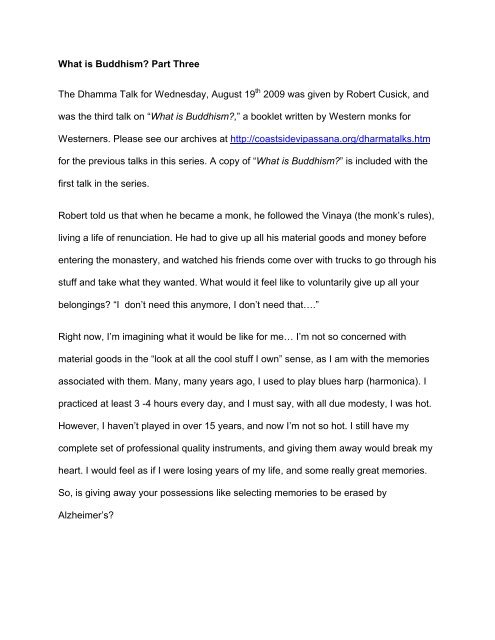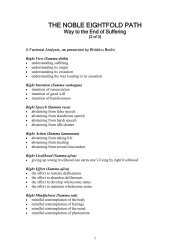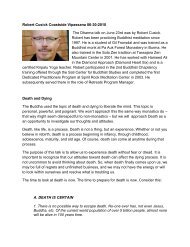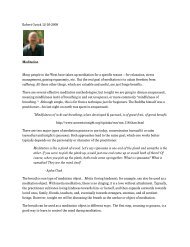What is Buddhism? - Coastside Vipassana
What is Buddhism? - Coastside Vipassana
What is Buddhism? - Coastside Vipassana
Create successful ePaper yourself
Turn your PDF publications into a flip-book with our unique Google optimized e-Paper software.
<strong>What</strong> <strong>is</strong> Buddh<strong>is</strong>m? Part ThreeThe Dhamma Talk for Wednesday, August 19 th 2009 was given by Robert Cusick, andwas the third talk on “<strong>What</strong> <strong>is</strong> Buddh<strong>is</strong>m?,” a booklet written by Western monks forWesterners. Please see our archives at http://coastsidevipassana.org/dharmatalks.htmfor the previous talks in th<strong>is</strong> series. A copy of “<strong>What</strong> <strong>is</strong> Buddh<strong>is</strong>m?” <strong>is</strong> included with thefirst talk in the series.Robert told us that when he became a monk, he followed the Vinaya (the monk’s rules),living a life of renunciation. He had to give up all h<strong>is</strong> material goods and money beforeentering the monastery, and watched h<strong>is</strong> friends come over with trucks to go through h<strong>is</strong>stuff and take what they wanted. <strong>What</strong> would it feel like to voluntarily give up all yourbelongings? “I don’t need th<strong>is</strong> anymore, I don’t need that….”Right now, I’m imagining what it would be like for me… I’m not so concerned withmaterial goods in the “look at all the cool stuff I own” sense, as I am with the memoriesassociated with them. Many, many years ago, I used to play blues harp (harmonica). Ipracticed at least 3 -4 hours every day, and I must say, with all due modesty, I was hot.However, I haven’t played in over 15 years, and now I’m not so hot. I still have mycomplete set of professional quality instruments, and giving them away would break myheart. I would feel as if I were losing years of my life, and some really great memories.So, <strong>is</strong> giving away your possessions like selecting memories to be erased byAlzheimer’s?
Renunciation has a significant positive effect, though. Letting go of all the materialgoods and money changes everything. Once you are able to let go, renunciation <strong>is</strong> not aburden – it’s freedom. Mediation goes much deeper when the worries, chores, andconcerns of daily life outside the monastery d<strong>is</strong>appear. The energy that supported thematerial goods goes to practice and meditation instead.Forty-five minutes prior to Robert’s talk, I had just fin<strong>is</strong>hed the first draft of a “Non-Authoritative Introduction to the Pali Canon.” Much to my surpr<strong>is</strong>e and delight, the firstpart of Robert’s talk covered the same material as in the first part of my draft, a copy ofwhich accompanies these notes. If you don’t mind jumping around, and I’m allowed tobe a little lazy, read A Non-Authoritative Introduction to the Pali Canon up to at least toThe Second Basket on page 10.…All done? Back to our story…In the early centuries of the Common Era, India was wealthy. Rich in gold and silver,and the only place in the world where diamonds were mined, it was a treasure chestand the envy of those less well off. Th<strong>is</strong> wealth attracted attention from neighboringcountries… and armies.In the 8 th Century, envy became violence. Arab armies plundered their way throughNorthern India, and eventually settled down in the conquered Sind region (Punjab).There was more to come. In the 11 th Century, Mahmud of Ghazna led armies of Turks
and Hindu mercenaries, and invaded central India 17 times in 25 years. By the 12 thcentury, Turks had conquered India, and establ<strong>is</strong>hed a Muslim Emperor. Buddh<strong>is</strong>m wasno longer tolerated, and had been exiled from India, surviving primarily in Sri Lanka andChina, and spreading out from there.In the exodus from India, Buddh<strong>is</strong>m began to take on character<strong>is</strong>tics of the lands andcultures through which it traveled. For example, the anim<strong>is</strong>m of Tibet became absorbedin Tibetan Buddh<strong>is</strong>m and populated it with demons and spirits, and then traveled toMongolia and Bhutan. Many different schools of thought arose in Buddh<strong>is</strong>m, reflectingthe localization and <strong>is</strong>olation from other groups. Over the years, these variations eitherdied out, or merged.One stream of Buddh<strong>is</strong>t thought migrated through China, Korea, Japan and Tibet, and<strong>is</strong> now known as Mahayana (“Great Vehicle”) Buddh<strong>is</strong>m. Included in th<strong>is</strong> school arePure Land, Chan, Zen, Nichiren, and Tibetan Buddh<strong>is</strong>m, prevalent throughout EastAsia.Another stream of Buddh<strong>is</strong>m came out of Sri Lanka and traveled through SoutheastAsia, including Thailand, Cambodia, Laos, and Burma. Th<strong>is</strong> stream <strong>is</strong> Theravada, or the“Way of the Elders” and <strong>is</strong> the Buddh<strong>is</strong>m brought to Sri Lanka by Ashoka’s son.Theravada <strong>is</strong> the oldest school of Buddh<strong>is</strong>m, and has changed little since Buddha andh<strong>is</strong> followers practiced it.Each school of Buddh<strong>is</strong>m tends to have its own set or definition of what sacred texts areincluded and studied. Theravada follows the Pali Canon (Tipitaka) from Sri Lanka and
the Buddh<strong>is</strong>t Councils. The stream of Buddh<strong>is</strong>m expanding from China, uses theChinese Canon. The Buddh<strong>is</strong>m that came out of China brought the Chinese Canon(and a great deal of the culture) to Korea, Vietnam, and Japan. The Tibetan Mahayanastream took the Tibetan Canon to Mongolia and Bhutan, along with Tibetan anim<strong>is</strong>m.The goals of Mahayana and Theravada Buddh<strong>is</strong>m are different. In Theravada, the goal<strong>is</strong> to become enlightened, i.e., become an Arahant. In Mahayana Buddh<strong>is</strong>m, on theother hand, the goal <strong>is</strong> to become a bodh<strong>is</strong>attva.There are different views of what a bodh<strong>is</strong>attva <strong>is</strong>. Generally, a bodh<strong>is</strong>attva <strong>is</strong> someoneon the way to becoming enlightened, but <strong>is</strong> deeply committed to helping others alsobecome enlightened. There are various types of bodh<strong>is</strong>attva, providing different types ofleadership and paths to enlightenment. Regardless of the path, the bodh<strong>is</strong>attva vow <strong>is</strong>what defines a bodh<strong>is</strong>attva. One such vow <strong>is</strong> “May I attain Buddhahood for the benefit ofall sentient beings.”Another kind of bodh<strong>is</strong>attva <strong>is</strong> someone who holds off on enlightenment until everyone<strong>is</strong> ready. Avalokitesvara (http://en.wikipedia.org/wiki/Avalokite%C5%9Bvara) <strong>is</strong> abodh<strong>is</strong>attva of th<strong>is</strong> type. Avalokitesvara <strong>is</strong> the bodh<strong>is</strong>attva of compassion, and <strong>is</strong> knownas Kannon in Japan, Chenrezig in Tibet, and Kwan Yin in China. Anyone who vows todelay their own enlightenment until all sentient beings are saved <strong>is</strong> following the way ofAvalokitesvara.In many representations of Avalokiteshvara, he <strong>is</strong> portrayed with multiple arms andheads (up to 1,000).
One prominent Buddh<strong>is</strong>t story tells of Avalokiteśvara vowing never to rest until hehad freed all sentient beings from samsara. Despite strenuous effort, he realizesthat still many unhappy beings were yet to be saved. After struggling tocomprehend the needs of so many, h<strong>is</strong> head splits into eleven pieces. AmitabhaBuddha [the Buddha of Infinite Light], seeing h<strong>is</strong> plight, gives him eleven headswith which to hear the cries of the suffering. Upon hearing these cries andcomprehending them, Avalokiteśvara attempts to reach out to all those whoneeded aid, but found that h<strong>is</strong> two arms shattered into pieces. Once more,Amitabha comes to h<strong>is</strong> aid and invests him with a thousand arms with which toaid the suffering multitudes.- http://en.wikipedia.org/wiki/Avalokite%C5%9BvaraFrom th<strong>is</strong> point of view of an Avalokitesvara, the Theravada goal appears rather self<strong>is</strong>h.Rather than helping all sentient creatures, the Theravadan appears to be going forh<strong>is</strong>/her personal salvation first.As one of the differences between the Buddh<strong>is</strong>t schools of thought, a counter argumenthas been made that only an enlightened person can help others become enlightened.Since a bodh<strong>is</strong>attva <strong>is</strong> not yet enlightened, there <strong>is</strong> no way the goals of enlighteningothers can be achieved by any bodh<strong>is</strong>attva.On the other hand, some people believe that enlightenment <strong>is</strong> a gradual process, andthe all-or-nothing state of enlightenment implied by Mahayana <strong>is</strong> m<strong>is</strong>leading. As a
person becomes more enlightened, they become more able to help others, and grow inw<strong>is</strong>dom.All those who practice mediation and follow the path to enlightenment interact withothers in a different way. The energy of meditation changes the world. The TheravadaBuddh<strong>is</strong>ts believe that the only way to help others achieve enlightenment <strong>is</strong> to follow thepath to personal enlightenment. Th<strong>is</strong> approach brings to mind the slogan, “Helpyourself, so you can help others.”Ahimsa <strong>is</strong> a Pali word that means non-violence, and it <strong>is</strong> the core of all Buddh<strong>is</strong>m. It <strong>is</strong>also <strong>is</strong> integral to other Indian religions such as Jain<strong>is</strong>m and Hindu<strong>is</strong>m. Gandhi used theprinciple of ahimsa to great advantage against the Brit<strong>is</strong>h empire.When Robert entered the monastery, he found that renunciation and the monasticd<strong>is</strong>cipline allowed him to take a deeper look into h<strong>is</strong> own practice of ahimsa. He didn’tthink he would have to spend much time on ahimsa – he was a very gentle, nonconfrontationalperson, and thought that aggressive, angry behavior was not an <strong>is</strong>suefor him.To h<strong>is</strong> surpr<strong>is</strong>e, ahimsa became h<strong>is</strong> #1 practice. With the life-changing practice offollowing the Vinaya, he became aware how often violent thoughts entered h<strong>is</strong> mind andflew away before he could act on them. Outside the monastery, when resentments andirritations arose, he would suppress them so quickly, that they were not v<strong>is</strong>ible. As amonk, he began to recognize how quickly h<strong>is</strong> mind turned to aggressive thinking – whenthe person ahead of him in line was taking too long or when he was mentally criticizing
others and inventorying their faults and shortcomings, he was astounded at how quicklythe lizard brain jumped up and urged him to knock those fools out of the way.Ahimsa <strong>is</strong> a world-saving character<strong>is</strong>tic of Buddh<strong>is</strong>m . Robert concluded h<strong>is</strong> talk byreading to us from “<strong>What</strong> <strong>is</strong> Buddh<strong>is</strong>m?”Buddh<strong>is</strong>m In the World TodayAt present, Buddh<strong>is</strong>m continues to gain an ever-widening acceptance incountries and societies far beyond its original home. Many people throughout theworld, through their own careful choice, are adopting Buddh<strong>is</strong>m’s peaceful,compassionate and responsible ways as guiding principles in their lives.Meditation has always been at the very heart of the Buddh<strong>is</strong>t path, and as itsproven benefits to both mental and physical wellbeing are becoming more widelyknown, meditation grows increasingly popular. When stress <strong>is</strong> shown to be sucha major cause of human suffering in modern society, the quieting practice ofmeditation <strong>is</strong> even more valued. The world in the 21st century <strong>is</strong> too small andvulnerable for us to live in <strong>is</strong>olation or conflict. In all its long h<strong>is</strong>tory no war hasever been fought to spread the Buddha‘s teachings. Tolerance, loving-kindnessand forgiveness, essential for world harmony and individual happiness, aregenerated and developed through virtuous behavior and more deeply throughBuddh<strong>is</strong>t meditation. When put into practice in everyday life, the path of theBuddha gradually cultivates the heart with harmlessness. Th<strong>is</strong> <strong>is</strong> then offered toall beings, especially oneself. There <strong>is</strong> no place for dwelling in guilt or self-hatredin Buddh<strong>is</strong>m. The down-to-earth teachings and practices of the Buddha
culminate in pure joy, unshakeable serenity and penetrating w<strong>is</strong>dom, qualitiesidentified with Buddh<strong>is</strong>m for over 2,500 years and sorely needed in today’s world.The gentle and sagacious peace of enlightenment <strong>is</strong> what makes the Buddha’smessage timeless and always vitally relevant.





